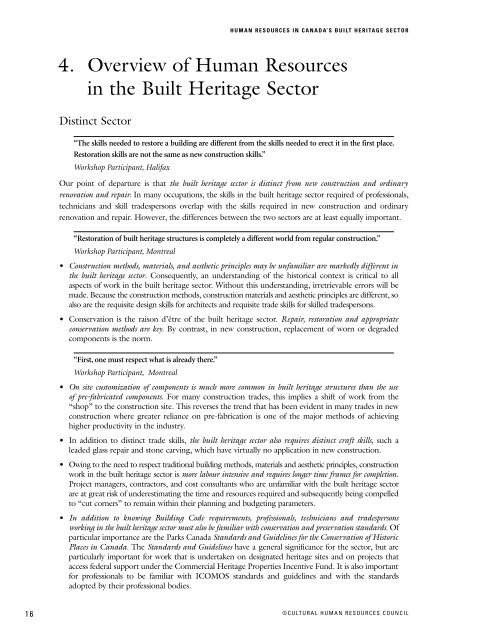Human Resources in Canada's Built Heritage Sector: Mapping the ...
Human Resources in Canada's Built Heritage Sector: Mapping the ...
Human Resources in Canada's Built Heritage Sector: Mapping the ...
- No tags were found...
Create successful ePaper yourself
Turn your PDF publications into a flip-book with our unique Google optimized e-Paper software.
HUMAN RESOURCES IN CANADA’S BUILT HERITAGE SECTOR4. Overview of <strong>Human</strong> <strong>Resources</strong><strong>in</strong> <strong>the</strong> <strong>Built</strong> <strong>Heritage</strong> <strong>Sector</strong>Dist<strong>in</strong>ct <strong>Sector</strong>“The skills needed to restore a build<strong>in</strong>g are different from <strong>the</strong> skills needed to erect it <strong>in</strong> <strong>the</strong> first place.Restoration skills are not <strong>the</strong> same as new construction skills.”Workshop Participant, HalifaxOur po<strong>in</strong>t of departure is that <strong>the</strong> built heritage sector is dist<strong>in</strong>ct from new construction and ord<strong>in</strong>aryrenovation and repair. In many occupations, <strong>the</strong> skills <strong>in</strong> <strong>the</strong> built heritage sector required of professionals,technicians and skill tradespersons overlap with <strong>the</strong> skills required <strong>in</strong> new construction and ord<strong>in</strong>aryrenovation and repair. However, <strong>the</strong> differences between <strong>the</strong> two sectors are at least equally important.“Restoration of built heritage structures is completely a different world from regular construction.”Workshop Participant, Montreal• Construction methods, materials, and aes<strong>the</strong>tic pr<strong>in</strong>ciples may be unfamiliar are markedly different <strong>in</strong><strong>the</strong> built heritage sector. Consequently, an understand<strong>in</strong>g of <strong>the</strong> historical context is critical to allaspects of work <strong>in</strong> <strong>the</strong> built heritage sector. Without this understand<strong>in</strong>g, irretrievable errors will bemade. Because <strong>the</strong> construction methods, construction materials and aes<strong>the</strong>tic pr<strong>in</strong>ciples are different, soalso are <strong>the</strong> requisite design skills for architects and requisite trade skills for skilled tradespersons.• Conservation is <strong>the</strong> raison d’être of <strong>the</strong> built heritage sector. Repair, restoration and appropriateconservation methods are key. By contrast, <strong>in</strong> new construction, replacement of worn or degradedcomponents is <strong>the</strong> norm.“First, one must respect what is already <strong>the</strong>re.”Workshop Participant, Montreal• On site customization of components is much more common <strong>in</strong> built heritage structures than <strong>the</strong> useof pre-fabricated components. For many construction trades, this implies a shift of work from <strong>the</strong>“shop” to <strong>the</strong> construction site. This reverses <strong>the</strong> trend that has been evident <strong>in</strong> many trades <strong>in</strong> newconstruction where greater reliance on pre-fabrication is one of <strong>the</strong> major methods of achiev<strong>in</strong>ghigher productivity <strong>in</strong> <strong>the</strong> <strong>in</strong>dustry.• In addition to dist<strong>in</strong>ct trade skills, <strong>the</strong> built heritage sector also requires dist<strong>in</strong>ct craft skills, such aleaded glass repair and stone carv<strong>in</strong>g, which have virtually no application <strong>in</strong> new construction.• Ow<strong>in</strong>g to <strong>the</strong> need to respect traditional build<strong>in</strong>g methods, materials and aes<strong>the</strong>tic pr<strong>in</strong>ciples, constructionwork <strong>in</strong> <strong>the</strong> built heritage sector is more labour <strong>in</strong>tensive and requires longer time frames for completion.Project managers, contractors, and cost consultants who are unfamiliar with <strong>the</strong> built heritage sectorare at great risk of underestimat<strong>in</strong>g <strong>the</strong> time and resources required and subsequently be<strong>in</strong>g compelledto “cut corners” to rema<strong>in</strong> with<strong>in</strong> <strong>the</strong>ir plann<strong>in</strong>g and budget<strong>in</strong>g parameters.• In addition to know<strong>in</strong>g Build<strong>in</strong>g Code requirements, professionals, technicians and tradespersonswork<strong>in</strong>g <strong>in</strong> <strong>the</strong> built heritage sector must also be familiar with conservation and preservation standards. Ofparticular importance are <strong>the</strong> Parks Canada Standards and Guidel<strong>in</strong>es for <strong>the</strong> Conservation of HistoricPlaces <strong>in</strong> Canada. The Standards and Guidel<strong>in</strong>es have a general significance for <strong>the</strong> sector, but areparticularly important for work that is undertaken on designated heritage sites and on projects thataccess federal support under <strong>the</strong> Commercial <strong>Heritage</strong> Properties Incentive Fund. It is also importantfor professionals to be familiar with ICOMOS standards and guidel<strong>in</strong>es and with <strong>the</strong> standardsadopted by <strong>the</strong>ir professional bodies.16©CULTURAL HUMAN RESOURCES COUNCIL










